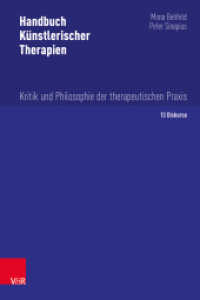- ホーム
- > 洋書
- > 英文書
- > Computer / General
Full Description
The volume set LNCS 15621-15622 constitutes the refereed proceedings of the 21st International Conference on Computer Analysis of Images and Patterns, CAIP 2025, which took place in Las Palmas de Gran Canaria, Spain, during September 22-25, 2025.
The 65 full papers were carefully reviewed and selected from 109 submissions. The proceedings focus on Facial and Video Recognition, Image Segmentation, Object Detection and Applications, 3D Vision and Reconstruction, Biomedical Imaging and Diagnostics, Model Robustness and Generalization, Multimodal and Vision-Language Models, Robotics, Interaction and Intelligent Systems, Emerging Methods and Vision Applications.
Contents
Biomedical Imaging and Diagnostics.- MDTACNet: MobileNet DenseNet and Transformer Attention Hybrid Network for Multi-Crop and Multi Disease Classification.- Ensuring the Origin of Cytological Whole Slide Images Through Preparation and Scanner Detection.- Unsupervised Mineral Segmentation with Graph Neural Networks and Multi Modal SEM Data.- Predicting Sheep Body Condition Scores via Explainable Deep Learning Model.- What Does Gait Reveal About Health? Investigating Human Motion as an Indicator.- Enhancing Synthetic CT from CBCT via Multimodal Fusion and End To End Registration.- Increasing Resolution of MRI Volumes Through Interleaved Slice Synthesis Based on Generative Adversarial Networks.- Model Robustness and Generalization.- Simultaneous Robustness and Generalization Using Nearest Neighbor Classifiers.- Adaptive Model Selection for Expanded Post Hoc Debiasing and Mitigating Varying Degrees of Spurious Correlations.- SelfExplaNETory: Improving Classification Accuracy with Local Post Hoc Interpretation.- SimEx ViT: Explainable Vision Transformer with Similarity-Based Attention Modulation.- Robust Logit to Enhance Stochastic Neural Network Adversarial Robustness.- Effective Relationship Between Characteristics of Training Data and Learning Progress on Knowledge Distillation for Image Recognition.- Multimodal and Vision-Language Models.- Automatic Audio Description: A Training Free Approach Using Foundation Models.- AMEST: Adaptive Morphologically Enhanced Subword Tokenization for Improved Language Model Perplexity.- Leveraging Vision-Language Models for Improving Detection of Obstacles on Railway Tracks.- Generalizable Detection of Student Engagement in Online Learning Environments.- LLM generated Semantic Co-occurrences for Multi Label Food Recognition.- Tracing Information Flow in LLaMA Vision: A Step Toward Multimodal Understanding.- Robotics, Interaction and Intelligent Systems.- Multimodal Audio Visual Emotion Recognition for Social Robotics.- Enhancing Collaborative Image Classification via Spatio-Temporal Graph Neural Networks: A Proof of Concept Study on Human Group Decisions.- Synthesizing Images with Different Exposure Settings for Low Light Image Enhancement.- DADO: A Depth Attention Framework for Object Discovery.- Ozone Concentration Estimation from Infrared Images Using Extinction Coefficient.- Multi modal Human-Robot Collaboration in Production Lines Through Speech Commands and Gestures.- Emerging Methods and Vision Applications.- Emotion Recognition in Contemporary Dance Performances Using Laban Movement Analysis.- Forecasting Sea Surface Temperature from Satellite Images with Graph Neural Networks.- PLRF-NMS: A Piecewise Linear Rational Function in Non-Maximum Suppression.- R3ST: A Synthetic Dataset with Real Trajectories for Urban Traffic Analysis.- Adaptive Meshes in Graph Neural Networks for Predicting Sea Surface Temperature Through Remote Sensing.- Beyond Splines: Legendre and Shmaliy Polynomial-KANs for Robust Image Recognition.








